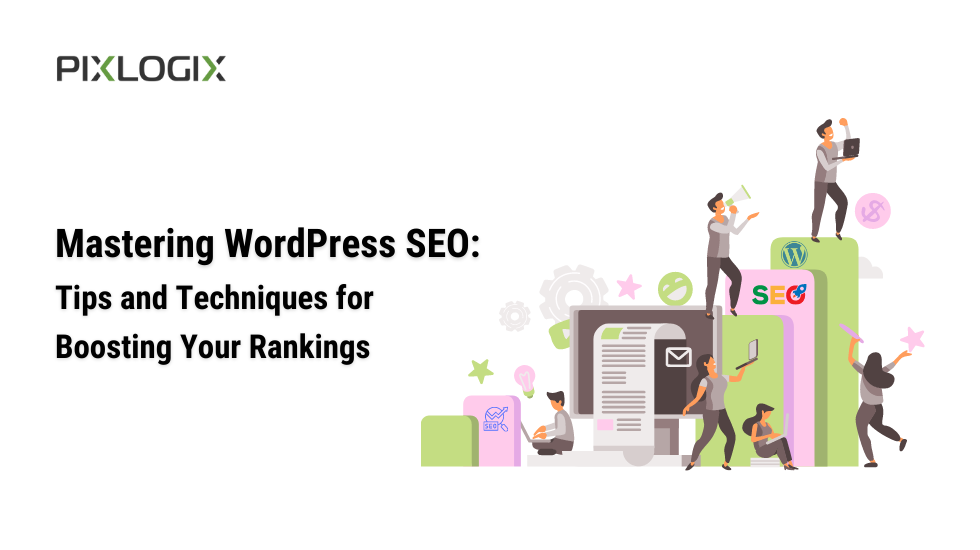Do you want to know WordPress SEO tips to optimize your WordPress website to rank well in search engines? This blog you need to read now.
Your WordPress website needs to have an SEO-friendly design for several reasons. With an SEO-friendly WordPress website, you can maximize your online visibility, improve organic traffic, better the user-experience, increase conversion rates, and gain a competitive advantage in the digital landscape by optimizing your website for SEO. Your website will benefit significantly from this long-term investment, as it can yield a significant return on investment over the long term.
In this blog post, we will discuss the 10 most important WordPress SEO tips that can help you improve your SERPs ranking in Google. You will understand better if you read until the end.
Top WordPress SEO Tips for Boost Your Website Ranking
Here is a list of some of the most effective WordPress SEO tips and practices that SEO experts use to improve the ranking of their websites.
#1: Add a Sitemap on Your Website
Adding a sitemap to your website is a crucial part of SEO. A sitemap is a file that contains a list of all the pages on your website and helps search engines understand the structure and organization of your site. Search engine bots constantly scan the web to find and index web pages. By providing a sitemap, you make it easier for search engines to discover and crawl all the pages on your site. This ensures that your content gets indexed properly, leading to better visibility in search engine results.
Moreover, when you add new pages or update existing ones, search engines may take some time to discover these changes. With a sitemap, you can alert search engines about the new content promptly, allowing for faster indexing and potentially quicker appearance in search results.
#2: Secure Your Website by Installing an SSL Certificate
The Secure Sockets Layer (SSL) encrypts the communication between a browser and a website. SSL encryption shields sensitive data on a website from being accessed by unauthorized parties. Your WordPress website will be more secure and will rank higher on search engines thanks to an SSL-certified domain.
An SSL-certified domain’s URL begins with https:// rather than http://. The browser additionally shows a padlock icon next to the web address.
#3. Produce High-Quality, SEO-Friendly Content
High-quality content that is relevant, informative, and engaging tends to rank higher in search engine results. Search engines, like Google, aim to provide the most valuable and relevant content to their users. By creating content that meets these criteria, you increase your chances of ranking higher and attracting more organic traffic to your website.
SEO is not just about pleasing search engines; it’s also about providing a great user experience. High-quality content satisfies the needs and interests of your visitors. When users find your content helpful and valuable, they are more likely to stay longer on your site, explore more pages, and return in the future. Positive user behavior metrics, such as low bounce rates and high time on page, can indirectly boost your search engine rankings.
In addition, you must frequently post new and updated material to attract more attention. Websites that regularly post new content are more likely to attract more visitors.
#4: Set up Canonical Tags for Duplicate Content
Search engines identify one URL as canonical when numerous URLs point to the same piece of content and crawl the duplicates less frequently. Multiple pages pointing to the same page, including www and non-www variants, resulting in duplicate content. Additionally, duplicating content occurs when mobile and desktop URLs are different.
A duplicate page could alternatively be the same page translated into a different language. If your website has a translation feature that doesn’t apply to all material, be sure to search for duplication. To assist in locating duplicate content, use web tools like Siteliner. In order to prevent duplicate pages from being crawled, set up canonical tags.
Add the code – rel=”canonical” property following the link to specify your preference for a certain page. Alternatively, canonical URLs may typically be configured using WordPress SEO plugins.
#5: Develop a Linking Strategy for Internal and External Sources
Developing a linking strategy is a crucial part, because it will affect your website ranking in the long run. There are mostly 2 types of linking strategy experts build for their business.
- Internal Links
- External Links
Internal links are clickable references to other web pages or blog entries on the same website. Internal connections often fall into one of two categories: contextual or navigational.
The primary structure of a website is often contained in its internal navigational links, they assist users in locating the desired page. The sidebar, footer, and navigation bar links are all considered internal links.
In the meanwhile, the content components include internal contextual links. Including internal links that point readers to relevant topics within blog entries is another method of internal linking.
Unlinke internal links where you build links between the same domain pages, external linking strategies are totally different. In the External links you can connect your website with the other domain web pages. These types of links enable visitors to delve deeper into a subject, especially when there is no information on your site that addresses it.
In addition to helping you establish authority and boost ranks, linking to authoritative websites also distributes link juice to your website.
#6: Build Do-follow Links
Another successful link-building tactic is to create do-follow links. Do-follow links are hyperlinks that pass on “link juice” or SEO value from one website to another. When a website links to another with a do-follow link, it essentially vouches for the linked website’s credibility and authority in the eyes of search engines.
As your website gains higher rankings due to do-follow backlinks from reputable sources, you are likely to experience an increase in organic traffic. Higher rankings mean more visibility in search results, leading to more clicks and visitors to your website.
Additionally, earning do-follow backlinks from trustworthy and authoritative websites can enhance your own website’s perceived authority and trustworthiness. When other reputable sites link to your content, it signals to search engines that your content is valuable and worthy of recognition.
#7: Keep UX in Mind
User-experience, or UX, refers to how users feel and perceive a website as they engage with it. Numerous elements, including visual elements, navigation, and website functionality, make up the entire experience. The page experience measurement is described by Google in their developer guide. Here are some suggestions to enhance the user-experience on a website:
- You can use a Responsive WordPress theme to make your WordPress website. This guarantees that your website will function and look fantastic on mobile devices.
- Another option is to Activate AMP. For activating AMP on your website, you can use the AMP WordPress plugins that are available in the plugins library. This will speed up the loading of your website’s mobile version.
- Also, by improving the navigation of the website, you can enhance your UX design. To prevent users from being lost on your website, make sure the navigation is straightforward. If you have a lot of pages to navigate, add submenus.
- Ideally, visitors shouldn’t have to browse down the page to find the answer to their question in your material. Visitors may quit your website if they can’t discover the information they need right away. So, to provide quality content and arrange that properly so your visitors can easily understand them.
- Last but not least, limit the number of pop-up windows. A poor user experience can result from too many pop-ups, banners for signup forms, or adverts.
#8: Turn on Breadcrumbs
Links called breadcrumbs are used to direct visitors to specific locations on WordPress websites. The navigation and user-experience of a website is enhanced by enabling breadcrumbs. It is especially helpful for websites with many pages and blog entries that are focused on content.
An excellent illustration of how breadcrumbs aid website visitors’ navigation may be seen on eBay. Users can use the breadcrumbs to click on earlier categories to identify related goods when looking for a product.
#9: Never Forget to Apply Local SEO Optimization
Your site will appear more prominently in local company searches thanks to local SEO. People might look for restaurants nearby, for instance. The search engine will locate businesses using their IP addresses and present search results for that region. One strategy to increase your local SEO is to create a local business profile on popular local business directories like Google Business Profile, Sulekha, Bing Places, etc. In this manner, you can show up on a search engine local search result map.
Create a local business profile and fill the NAP information (Name, Address, Phone Number) about your company for local SEO. In local searches, this information influences the results. With this information, a search engine considers your company’s proximity and relevancy to the search query as well. Conducting local keyword research and tweaking your pages is another local SEO strategy.
#10: Incorporate a Subscription Box for RSS Feeds
A web feed called Really Simple Syndication (RSS) enables subscribers to easily access updates from your website. Although RSS feeds don’t directly affect SEO, they can help you rank higher by increasing organic traffic and visitor engagement. WordPress websites come with RSS enabled by default. You can create an RSS feed by adding in the last of your domain like this “ Yourdomain.com/feed”. Users will often utilize this link to add the website to their feed with most RSS feed reader programs.
Include an RSS social icon on your website and link it to the URL of your RSS feed to inform visitors that you have one. Add the social icons block and insert an RSS Feed icon, if you’re using a WordPress block theme. Enter the URL for your RSS feed to save your changes.
Final Notes
SEO is a long-term approach. Therefore, patience and persistence are required if you’re going to utilize these WordPress SEO tips. However, if you still have any queries, get in touch with an SEO services provider. They will provide you in-depth information about how SEO Options work for your business website.
If you’re looking to hire India’s top Organic SEO services, Pixlogix Infotech Pvt. Ltd. is a wonderful choice for you. It has a team of highly skilled SEO professionals who offer you remarkable solutions. Unlike others, it does not provide you with a pre-build plan that adequately meets your needs. Instead, its skilled workforce is renowned and relied upon for its superior, individualized solutions. You can get in touch with www.pixlogix.com for further information.


